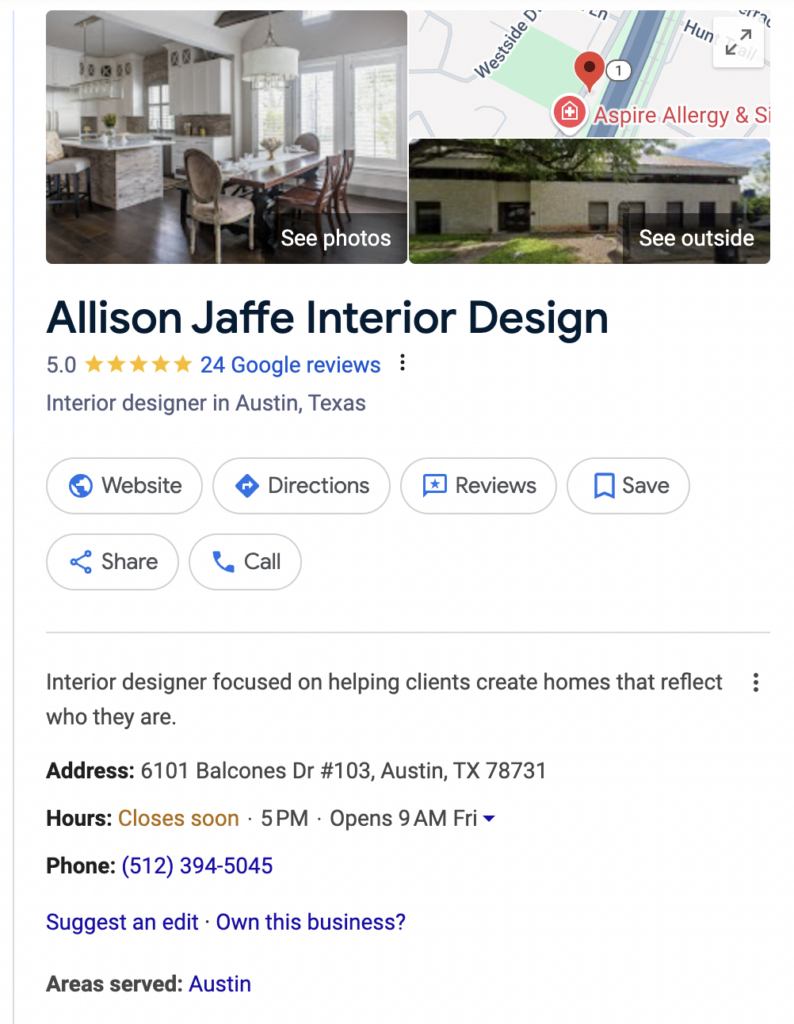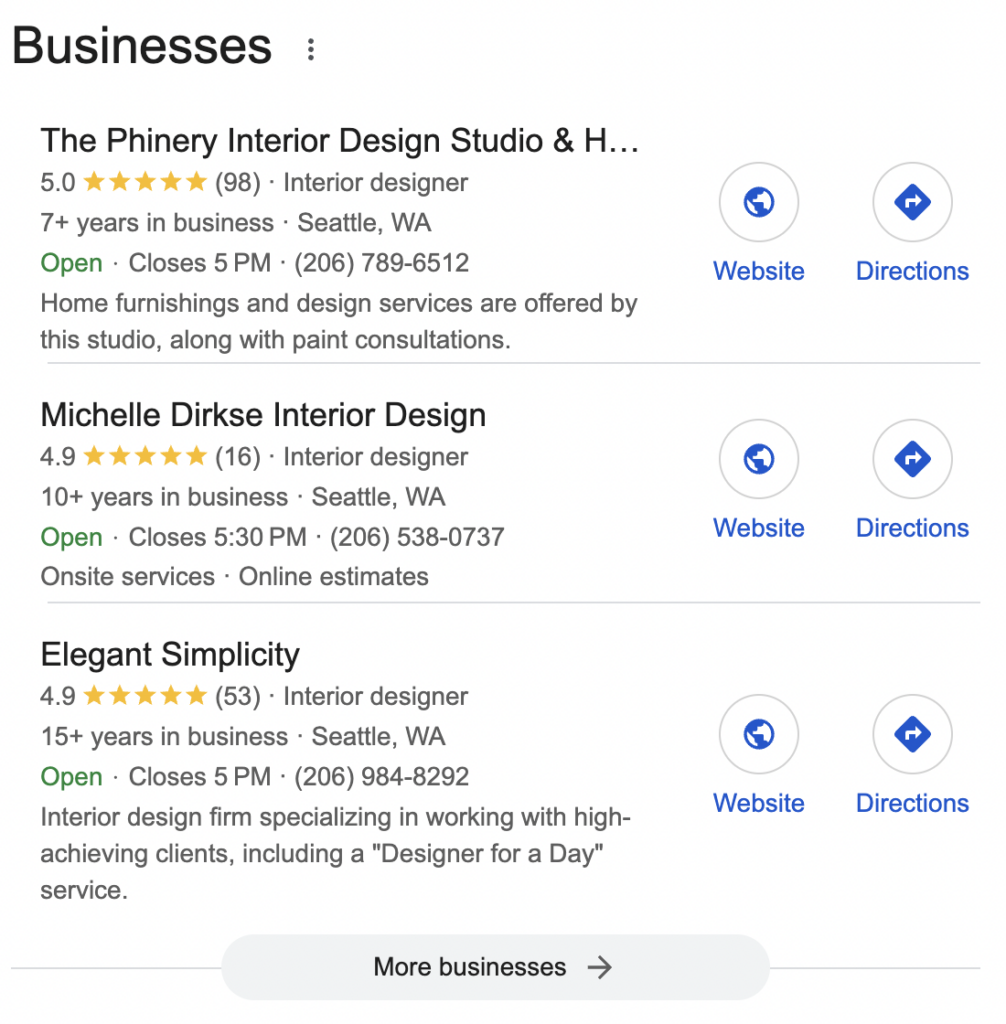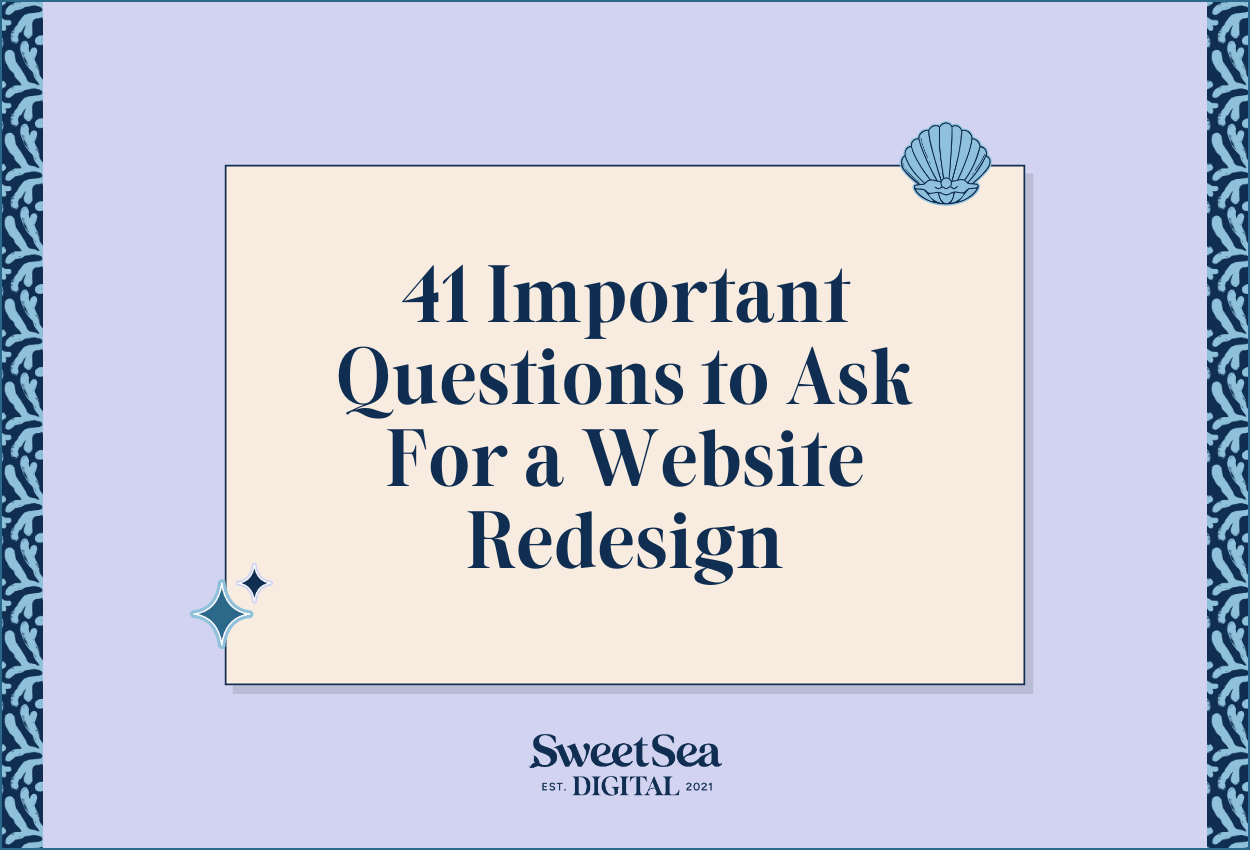SEO For Interior Designers: Getting Clients (w/ Keywords!)
By Seren Nurgun,
Founder of SweetSea Digital
By Seren Nurgun
Mar 20, 2025
Salt Your SEO:
Kickstart Your SEO With These 5 Easy Steps!
Imagine a world where your beautiful interior design business stands out and passively attracts dreamy clients, letting you focus only on tasks that bring you joy. What if I said there’s a potential reality where that’s very possible, if not likely, with the right implementation of search engine optimization (SEO).
You’re probably thinking, “I’ve heard this before”. And that’s totally valid – a lot of SEO guides and providers rave about how amazing it is. But we keep it real around here! SEO for business isn’t all sunshine and rainbows – there’s lots of nuances and intricacies.
So you’ll be happy to know that this interior designer’s beginner’s guide keeps all of this in mind so that you can start doing SEO in a sustainable, no-stress kind of way!
Starting Local SEO from Scratch
The art and science of SEO (as I like to say) is much like designing a luxurious, cozy den in a family home. It requires skillful arrangement and thoughtful consideration of all elements to create a cohesive harmony – not with furniture or decor, but with keywords and backlinks.
And this isn’t just about boosting your rankings on Google; it’s about transforming how potential clients find you online and what that means for your life as your own boss. And believe me when I say there’s nothing quite as satisfying as watching your website rise from the deep and swim up those rankings!
Because you’re here, you already know that SEO for interior designers can be a serious game-changer, but where exactly do you start? Well, buckle up. We’re about to dive into search engine optimization best practices that you can start implementing today as a non-techie founder.
To kick things off, let’s talk foundations first. What does it mean when we say ‘drive organic website traffic’ or ‘increase online search visibility’? Simply put, these are unpaid (i.e. not advertising) ways of getting more dreamy leads onto your website through a ton of different optimizations that, when looked at holistically, Google loves to see.
Understanding these practices helps you create an online search presence that appeals not only to human eyes, but also to those behind-the-scenes web-crawling bots that are responsible for deciding where to rank individual webpages for different keywords. But remember: don’t try tricking or hacking them because you’ll ultimately damage your website’s reputation with Google (which may not EVER recover).
How to Get Started With Keywords
When it comes to SEO, keywords are the backbone. They’re what your dreamy potential clients are typing into Google and searching for. Get your keywords right and the optimization of everything else may not matter as much. Get your keywords wrong and struggle to rank highly (and stay ranking highly).
That’s why targeting the most strategic keywords is so important! And every business’s website starts at a different starting point, even if you’ve never intentionally implemented SEO you may have already done some beneficial things you’re not aware of.
To get your keywords right, you need to know the difference between short-tail and long-tail keywords. Short-tail are keywords that are more broad and general, like ‘interior designer’ or ‘interior home design’. These are searched for way more than long-tail, but are also way more competitive and harder to rank highly for. Long-tail keywords are more specific and searched for less often, but typically have higher conversion rates and are therefore more profitable! Think of keywords like ‘luxury interior designer boston’ or ‘modern eco-friendly interior design trends for millennials’.
If your website is brand new, your E-E-A-T is most likely very low. E-E-A-T stands for experience, expertise, authoritativeness, and trustworthiness, and is the idea that Google prioritizes these elements when ranking websites. So if your website is new and your E-E-A-T is low, I recommend focusing only on finding long-tail keywords to put across your website. Right now, putting any short-tail keywords would be a waste of your time.
On the flip side, if your website has been around for more than a few months, your E-E-A-T is probably not that low anymore. Now, I recommend still focusing mainly on long-tail keywords but you can definitely start to incorporate more short-tail keywords especially when blogging.
Where To Put Keywords On Your Website
So now that you have a bunch of long-tail keywords, you’ll want to sprinkle (emphasis on sprinkle!) them across your website. Mainly choosing one main target keyword phrase for each page, like ‘colorful interior design services in austin tx’ for your services webpage. Be sure to put each page’s main target keyword in the page’s SEO Page Titles setting: how to add SEO Page Titles in Squarespace, how to add SEO Page Titles in Showit, how to add SEO Page Titles in WIX.

Another optimization you’ll want to do is include contextual keywords (like ‘design trends’ or ‘personalized decor’) throughout your web copy, without overdoing it because it needs to sound natural. This gives Google more valuable information on what your website is all about so that its algorithms can rank it more accurately.
Best Beginner-Friendly Keyword Research Tools
Potentially Good Keywords For Interior Designers
- modern interior designer in [city]
- luxury interior design services in [neighborhood]
- strategic home staging in [city]
- fun kitchen and bath design
- online consultation service
- full service interior decorating services in [city]
- home office interior designer for remote workers
- interior designer for remodels
- affordable interior designer in [county]
- residential interior design firm
- interior designer for new millennial home owners
Don’t tread in the SEO waters all by your lonesome! Check out our ROI-focused monthly SEO signature blogging service that takes it all off your plate, so you can focus on the fun things that bring you joy.
Build Local Citations for Improved Local Visibility
If you’re looking to boost your interior design business’s local online visibility, it’s time to start building citations (aka backlinks). What are citations? Simply put, they’re mentions of your business across the web – think name, address and phone number (NAP). Backlinks are links from other websites to your website. When done right and ethically, these are powerful signals to Google that your website is worth linking to (i.e. trustworthy and authoritative).
Citations matter because they provide critical information about your interior design business that helps search engines like Google understand where you’re located and what services you offer. When these details appear consistently across various websites and directories online, it strengthens trust in the accuracy of your business data.
The Role of Citations in Local Searches
A citation is not just a simple listing; it’s a valuable piece of real estate on the internet. It includes essential details such as your business profile and contact information (including phone number and physical address). This can make all the difference when people are searching locally for ‘interior designer near me’ or for similar things.
In fact, studies show that they’re the 5th most significant ranking factor for local map visibility and the 4th most important signal for local organic search results.
While setting up citations may sound monotonous or tedious, it’s definitely worth it! When it comes to SEO, every little bit of optimization helps. That time is never wasted.
Let’s imagine each citation being like another door leading towards greater opportunities – every additional one increases the chances of potential customers finding you. Now that’s a simple yet powerful tactic to boost your interior design business’s visibility in local searches.
I recommend starting with interior designer directories! Prioritize the free ones, but if there’s a paid one that’s considered highly authoritative and trustworthy in the interior design industry (like Designer Society of America’s directory or Architectural Digest’s directory), then I definitely recommend adding yourself on there.
Optimize Your Google Business Profile
Your Google Business Profile is like the online welcome mat to your interior design business. It’s a snapshot of what you’re all about and what you do, inviting potential clients to explore more.
An optimized profile that uses beautiful and engaging imagery in its listing receives a whopping 35% more clicks to their website than those that do not – that’s the power of having an optimized (and visible!) Google Business Profile.

How to Make the Most Out Of Your Google Business Profile
A strong profile doesn’t just look good – it works hard for your business too. Think of it as a 24/7 sales rep, pitching your design services even while you’re busy walking your furry friend or trying to keep your balance in a yoga class (IYKYK lol).
The first thing people see when they search ‘interior designer’ in their local area is likely going to be Google’s Local Pack. That little box of local businesses that pops up at the top – yep, that one. And guess what? The information there comes straight from – you guessed it – Google Business Profiles.

Essential details, such as the address, open hours, and contact number of your business, are incredibly important. If any info isn’t correct or missing altogether… well let’s just say things might get awkward fast with prospective clients misunderstanding important things about your business.
As an interior designer, unless you have a physical office, you’ll want to set your Google Business Profile to a Service Area profile. This just means that you offer services to a local area, but don’t have a physical location. Don’t try to put in a PO Box or something – trust me that that’s not a good idea.
- Ensure all information listed on your profile – including contact details – is accurate and updated regularly (especially for upcoming holidays)
- Show off reviews from satisfied customers (easy wins!) and respond promptly and professionally to both positive and negative feedback
- Add high-quality photos (and a short video or two) of your completed designs (nothing says “come hither” quite like visually appealing images, right?)
- Highlight what your business offers, whether it’s just interior design services or more
- Make sure your business categories are ‘interior designer’ and ‘interior decorator’
- Don’t put any keywords in your business’s title (i.e. only put your business’s name in the title of your Google Business Profile)
All these factors contribute significantly to optimizing not only the user experience but also your studio’s visibility across search engines (yep, including our beloved friend Mr. Google). Once you’ve built a solid profile foundation, I highly recommend growing organic visits to your Google Business Profile as much as possible. It can make a huge difference!
Conversion-Oriented Website Tips
The art of optimizing a conversion-oriented website for your interior design business is akin to getting every last decorative piece looking amazing in cohesive space. It may appear intimidating at first, but with determination and repetition, you got it!
Free tools like Google Analytics and Hotjar are key. These tools let you track how visitors interact with your site, which helps inform strategic adjustments for boosting conversions. Both are relatively easy to set up, even if you’re not technologically savvy. Simply follow their step-by-step instructions for your specific website platform (ex. Squarespace or Showit).
The Importance of On-Page SEO
Effective on-page search engine optimizations make sure that those folks looking for ‘interior designer near me’ find their way to your website instead of getting lost in the search engine labyrinth (or worse, end up on competitors’ websites).
A well-structured website increases the chances Google will rank your webpages higher – bringing even more future clients through YOUR doors. Include links to your main pages in your top navigation bar and don’t bury any pages; make sure each page on your website can be found through at most 3 clicks.
You’ll want a strong internal linking structure, meaning the links between different pages on your website should guide visitors around smoothly and without any confusion. If you’re really interested in this topic, check out this highly rated book on optimized web design that I’d super recommend!
Keeping Up With Changes & Updates
If there’s one thing constant about a service-based business, things change often. From your brand messaging to temporary sales and promotions to new before and after photos, revamping your website regularly keeps things fresh and is SO important to maximize success.
As an interior design business, I recommend keeping photos as fresh as possible! Whenever you’re finished up with a client, be sure to always take amazing photos you’d be proud to showcase on your website. Aside from having images across the entire website, also have a separate portfolio page that highlights the specific projects you’re most proud of.
I also recommend adding these new photos to your Google Business Profile! While you’re doing that, at the same time, maybe delete a couple of photos that are on the older side and that don’t showcase the vibe you’re going for anymore.
Mobile-Responsiveness
We live in a mobile-first world with over 62% of web page views worldwide occurring on mobile devices as of January 2025. But let’s not forget about desktop and tablet users who appreciate high-quality photos too! To cater to all audiences and improve site rank simultaneously, we’re talking responsive web design here – that’s where images scale beautifully and automatically no matter the device size.
If your website uses a popular website platform like Squarespace, Showit, or WIX, this is all done for you! But if your website is custom coded or built on WordPress, I definitely recommend testing your website across different devices and, if they’re not looking good, working on getting that fixed. Use this free website responsiveness tool to easily do that testing.
Let’s make your interior design business’s website not just another site in the vast digital universe but a vibrant, thriving online home where people find value, find connection, and most importantly find their way to booking your design services. Remember, having a website is only the beginning – your ongoing commitment to these optimization strategies will ensure a greater and brighter success!
Leverage Social Media for E-E-A-T
For any interior designer, building expertise, experience, authoritativeness, and trustworthiness (E-E-A-T) is a must, especially these days. E-E-A-T is a crucial component of SEO because it’s largely how Google views websites and determines rankings. How can you make this happen in the easiest way possible? Simple answer: social media.

How to Grow Your Social Media to Benefit Your SEO
Social media has officially become an integral part of marketing for local businesses, including interior designers. Leaked Google documents in 2024 confirmed that brand authority and reputation are highly important to SEO. And the easiest way to improve your brand’s authority is to build up your social media accounts.
Because interior designing and decorating is such a visual practice, I recommend focusing on visual-forward social media platforms like Instagram and Pinterest.
And a side benefit of pinning (just by the way) is that it’s a two-pronged strategy – you publish SEO-friendly blog posts that rank on Google and then pin those to Pinterest to rank highly there. The same piece of content gets double the visibility!
The more quality content you post on these platforms, the higher chances of engagement from dreamy potential clients. That being said, you don’t want to go overboard and post 10 times a day in-feed (in IG Stories, 10 times a day is totally ok). There are a million and one ways to engage followers, but if you’re struggling with what to post you’re not alone! I recommend checking out resources by these amazing social media experts: Mya Nichol, Xanthe Appleyard, Katie Campbell.
The more your social media accounts grow, the more people search for your brand on Google, and the more of a positive SEO signal that sends to Google. For marketing a business online, everything is now connected to everything else. Even if indirectly.
How to Strategically Blog as an Interior Designer
Creating a strategic blog helps interior designers get in front of those ultra dreamy potential clients and grow authority in the industry at a much faster pace. But what does ‘strategic’ blogging really mean?
In essence, it’s about producing long-form written content that appeals to both search engines and the people searching for all things related to working with an interior designer. Your target audience should find value (entertainment, education, inspiration, or thought-provocation) in every blog post you hit ‘publish’ on.
Blog Consistently to Become Google’s New BFF
To start, consistency is key. I know marketers say that about everything, but when it comes to SEO, it really is extremely important. When your website is just a baby, it takes at least a couple of months for Google to even start getting an idea of what you’re all about.
Consistently publishing high-quality, value-driven blog posts is known to speed up this process. Especially because search engines like Google love fresh content – they see regular updates as a sign that your site is active and relevant.
Also, each new blog post opens up a ton of opportunities for ranking for different keywords. Think of it this way – if you don’t publish that blog post about up-and-coming interior design trends, the people in your city searching for that won’t probably ever find your business.
So if your business is going all-in on SEO this year, strategic blogging consistently should be priority numero uno.
Make Every Post Count with SEO Best Practices
All this doesn’t mean that throwing together any old blog post will do; each one needs careful crafting using best practices such as realistic keyword research, internal and external linking, anchor text optimization, image optimization, etc. Not to get too technical, but these things are important!
True SEO magic happens when these technical elements meet compelling storytelling and writing – drawing readers in while satisfying algorithmic needs (I know – why can’t we just free-write and rank at the top, ugh!).
Show Up to Local Events
Your interior design business is no doubt an essential part of your neighborhood and larger city. Not only do you help people fall in love with their spaces, but you also inherently foster joy and human connection – which are sorely scarce these days. Showing up to local shindigs proves that you genuinely care about your city, and not only stretches your web presence but also strengthens the trust factor with both people and indirectly search engines.
Word-of-mouth is also a super strong marketing channel – when people recommend your services to their friends, that’s word-of-mouth marketing and is one of the best marketing channels because people trust their friends and family members a lot more than they do ads, social media, and other marketing channels.
Become a Giving Part of Your Community
When you’re involved locally, people get to know you as more than just another business owner – they see you as an active part of their community. This humanizes your brand and helps potential clients connect with you on a much deeper level.
Your participation at these events doesn’t have to be grandiose (you don’t have to spend thousands on sponsoring events or teams); simply being present can go miles towards building relationships and gaining visibility. For example, you could volunteer at a charity event or festival, run a charity drive, lead a clean-up, or even just show-up as a participant at local events while wearing a t-shirt with your business name or logo (tip: use UberPrints – they have a 4.7/5 rating with 4,000+ reviews).
How does this volunteering out in the world help SEO? Well, you remember that t-shirt I recommend you to wear? This will get people directly searching for your brand online, and that’s a big signal to Google that people are caring about your brand (therefore, Google should too).
Ready To Dive In?
Don’t tread in the SEO waters all by your lonesome! Check out our ROI-focused monthly SEO signature blogging service that takes it all off your plate, so you can focus on the fun things that bring you joy.
Seren Nurgun
SEO pro and founder of SweetSea Digital, Seren has proudly generated over 278,000 organic clicks from Google and worked with awe-inspiring 6 and 7-figure business owners. Ethical, sustainable marketing is her jam.
Read These Next
Before you go any further…
Hi! I’m Seren, the writer!
Hi! I’m Seren, the writer!
An SEO pro since 2021, I’ve generated over 278,000 organic clicks from Google and worked with 6 and 7-figure business owners. Starting, running, and growing a business definitely isn’t the easiest thing you’ll ever do (to put it lightly), so this treasure trove of blog posts is purely focused on making your life that much easier. You’ve found one of my favorite places on the internet, so I won’t hold you any longer - happy reading!
But first!
Start your SEO journey on strong footing.
Benefit from the free Salt Your SEO guide, weekly newsletters with actionable tips, and some promotions you might not want to miss.
We’re not jerks! Your email will never be spammed, sold, or otherwise treated poorly.

FREE
GUIDE
A Boutique SEO Agency For Woman-Led Online & Local Businesses
A Boutique SEO Agency
For Woman-Led Online
& Local Businesses
who are ready to leverage the world’s
#1 search engine & make sales on repeat.
Navigate
Learn
Let's Connect
© 2021-2025 SWEETSEA DIGITAL, LLC
Brand Photography by Halle Alessia
SITE DESIGN BY CREATE & WANDER
Operating from the unceded ancestral homeland of the Tequesta people
Because we value your trust, we want to share that this page may contain unique affiliate links, which means that we may receive a financial exchange (at no cost to you) if you make a purchase. We only recommend the tools that we actually love and 100% ethically stand behind (because you deserve the best!).


